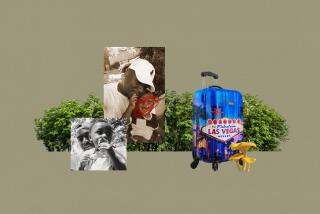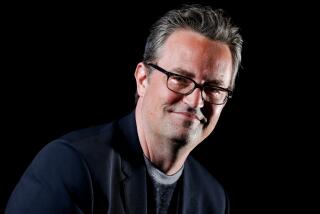AIDS : The Patients : One Man’s Quest for Survival Is His Therapy
- Share via
Rick Anderson has made the pilgrimage to Tijuana for unsanctioned drugs. He has painted a photographic chemical on his upper arms. He eats spoonfuls of a white powder used against nickel poisoning and spreads a lecithin-and-butter concoction onto his morning bread.
He is fluent in the mysteries of T-cell fluctuations, double-blind studies and advances in psycho-neuro-immunology. He possesses a familiarity with foreign research on obscure drugs not often found in other 29-year-old data processors.
“It’s very much a part of my life,” Anderson said of his quest for a cure for his disease. “It’s a survival technique, you might say. Without it, I wouldn’t survive.”
In many ways, his search is his therapy. He spends hours each day reading, making telephone calls, hunting down facts. Like all such quests, Anderson’s is fueled in part by blind faith. He cites his mother’s adage: God put something on this Earth for everything.
He finds hope in small signs of progress--like those mornings he can get up without feeling exhausted. He avoids bad news--and, sometimes, doctors: “They take my hope away. You take my hope away and I feel awful for a week.”
Anderson said he is sure his experimental treatments are working. Diagnosed with AIDS-Related Complex (ARC) in 1984, the disease has not progressed to full-blown AIDS. He also feels liberated by his bucking of medical authority. He said it has allowed him to grow.
“I think initially, that’s how this battle started with me: I wasn’t comfortable with dying,” Anderson said recently, hunkering down to a plate of poached eggs and corn beef hash in a San Diego deli. “Now I’m comfortable with dying. I just don’t want to die.”
Anderson described himself as a man once ignorant about his body, a man who didn’t even know what his lymph nodes were when doctors announced they were ominously swollen. They told him the funguses he had had since 1981 probably came from the AIDS virus.
Loss of Control
He remembered having felt at that moment a terrifying loss of control. He recalled having put on his clothes in a speechless panic. He walked out of the doctor’s office into the San Diego sun with no idea of what he was going to do.
His first lead came from a television broadcast about the drug Isoprinosine: AIDS patients were buying it in Mexico because it was not approved in the United States. Believing the television tip was somehow preordained, perhaps by God, Anderson set out on what was to become his quest.
The drug had been available abroad since the late 1960s, he learned. He called the manufacturer, the American Medical Association, the U.S. Food and Drug Administration. When the FDA said the drug would neither help not hurt, Anderson decided to give it a try.
“It was very scary--to medicate yourself, to do a chemotherapy on yourself. That’s a very tough experience, for someone to deviate from the medical community,” Anderson said. But looking back, he insisted firmly, “It’s the best thing I ever did.”
After taking the small white pills twice a day for two months, Anderson said his funguses went away. His chronic fatigue began to burn off like fog. But after a few more months on the drug, its effects seemed to wear off. Anderson began looking for something new.
New Treatments
This time, he went back to a Tijuana pharmacy and bought Ribavirin, which he had learned about from a friend and had read up on. For eight months on the drug, he said, he had his blood monitored. The crucial number of T-cells, the white blood cells that play a key role in the functioning of the immune system, appeared to be on the rise.
The AIDS virus erodes a sub-group of T-cells, called T-4 helpers, which normally bolster the immune system by stimulating other white cells that generate antibodies.
Meanwhile, Anderson also tried DNCB, a chemical found by a San Francisco dermatologist to stimulate the T-cell development when painted on the upper arm. Burgeoning guerrilla clinics in San Diego were “networking” the chemical and Anderson picked it up from a friend.
Once again, the initial results were exhilarating: Anderson remembered feeling so well that he went out partying that Halloween night. Asked about side-effects of any of the drugs, Anderson said with a shrug: “Who can say what’s the disease and what’s the drug?”
“People are going to look at this and say, ‘Boy, he’ll eat anything,’ ” said Anderson, who supports himself and his treatment with disability payments. “I do it as cautiously as I can. But given the nature of my situation, I can only be so cautious.”
These days, Anderson is taking Imuthiol, a chemical used against nickel poisoning and being tested as an immune stimulant. Anderson happened upon it in a directory of alternative treatments. It seemed to suit his symptoms, so he got it through a chemical supply house.
He also uses a home-made version of AL 721, a lipid developed in Israel that is believed by some to inhibit the AIDS virus. He buys the egg lecithin in the mixture from a health food store, mixes it in his kitchen and spreads the gooey concoction on bread at breakfast.
Spiraling Costs
Anderson has dropped the Mexican drugs, having decided he would like to find a less toxic alternative. In addition, the prices of both in Tijuana have been steadily rising; toward the end, Ribavirin alone was costing $300 a month.
He said he could not afford the only approved drug, AZT, estimated to cost $10,000 a year. As for entering experimental drug trials, he is daunted by their prohibition on trying other approaches and by the possibility of being in the group that receives a placebo.
In the meantime, Anderson has cut down on meat consumption and dropped alcohol. He had given up smoking before he was diagnosed. He has become a believer in “visualizations” to restore health, convinced of what he calls “the power of the mind over the body.”
Over the past few months, Anderson has taken to dropping into long, hot baths, accompanied by a candle and a stress-reduction tape. While he soaks, he meditates, hoping to visualize himself back to health.
“I tell myself I’m healthy--not that I’m getting healthy,” said Anderson. “Because that implies you’re not.”
More to Read
Sign up for Essential California
The most important California stories and recommendations in your inbox every morning.
You may occasionally receive promotional content from the Los Angeles Times.










